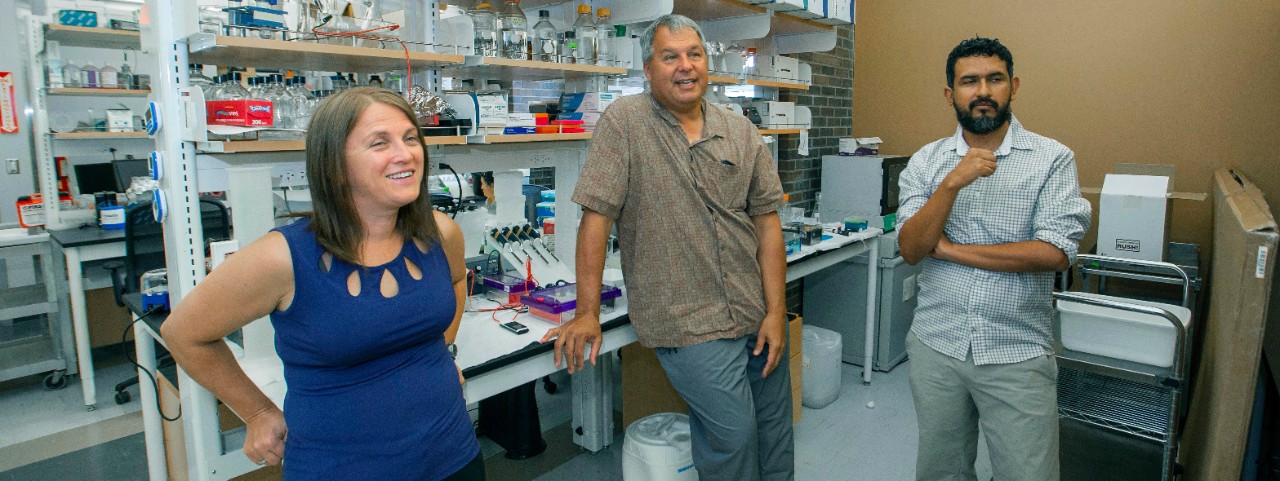
Genetic diversity couldn't save Darwin's finches
University of Cincinnati biologists found that extinct populations of Galapagos finches had higher genetic diversity than many survivors
A study by the University of Cincinnati found that Charles Darwin’s famous finches defy what has long been considered a key to evolutionary success: genetic diversity.
The research on finches of the Galapagos Islands could change the way conservation biologists think about a species' potential for extinction in naturally fragmented populations.
UC graduate Heather Farrington and UC biologists Kenneth Petren and Lucinda Lawson found that genetic diversity was not a good predictor of whether populations of finches would survive. The study was published in the journal Conservation Genetics in August after appearing online in April.
A UC lab analysis of century-old museum specimens found that six of eight extinct populations had more genetic diversity than similar museum specimens from which descendants survive today. In most other species, low genetic diversity is a signal of a population in decline.
Researchers examined 212 tissue samples from museum specimens and living birds. Some of the museum specimens in the study were collected by Darwin himself in 1835. Only one of the extinct populations, a species called the vegetarian finch, had lower genetic diversity compared to modern survivors.
The study demonstrates UC's commitment to research as outlined in its strategic direction called Next Lives Here.

A three-dimensional computer animation helps researchers compare the morphology of different finch species. Graphic/Jose Barreiro
If Darwin fully understood what was going on, it might have blown his mind.
Kenneth Petren, UC biology professor on genetics of Galapagos finches
Lawson said the findings are explained by the fact that these birds can migrate in between populations.
Specifically, researchers believe a biological phenomenon called sink-source dynamics is at play in which larger populations of birds from other islands act as a “source” of immigrants to the island population that is naturally shrinking, the “sink.” Without these immigrant individuals, the natural population on the island likely would continue to dwindle to local extinction. The immigrants have diverse genetics because they are coming from a variety of healthier islands, giving this struggling “sink” population inflated genetic diversity.
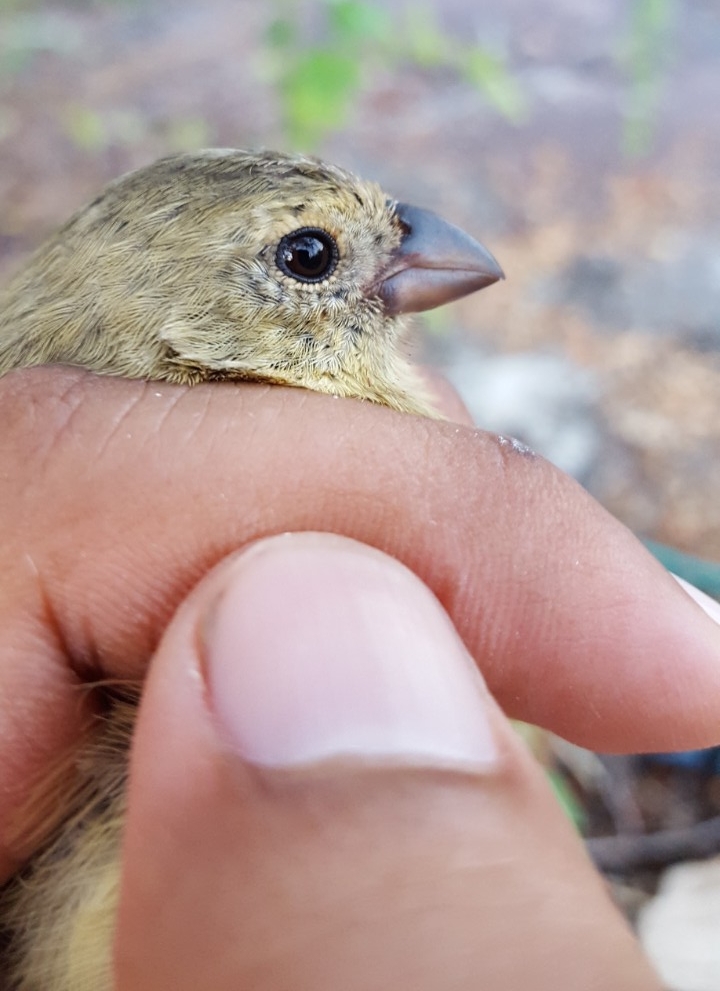
A small tree finch. Photo/Jose Barreiro
Petren said the findings serve as a warning that the genetics of individuals in fragmented populations might not tell the whole story about a species. And that is important for scientists who increasingly use genetics to account for the flow of genes between populations when determining a threatened species’ likelihood of extinction.
“The promise of genetics is to sample a few individuals to understand the whole population. But it’s a cautionary note that you might be sampling a fragment. You could be misled,” he said.
Petren has been studying the birds for 25 years at UC’s McMicken College of Arts and Sciences. He said the island’s 18 recognized species of finches are unusual for other reasons. Some finches that look most different are actually closely related, he said. And similar-looking finches that birders might have trouble telling apart are actually far apart on the evolutionary family tree.
“It’s a paradox. If Darwin fully understood what was going on, it might have blown his mind,” Petren said. “These finches are not the first case you would pick to formulate the notion that species can change over time because the patterns of change are so complicated.”
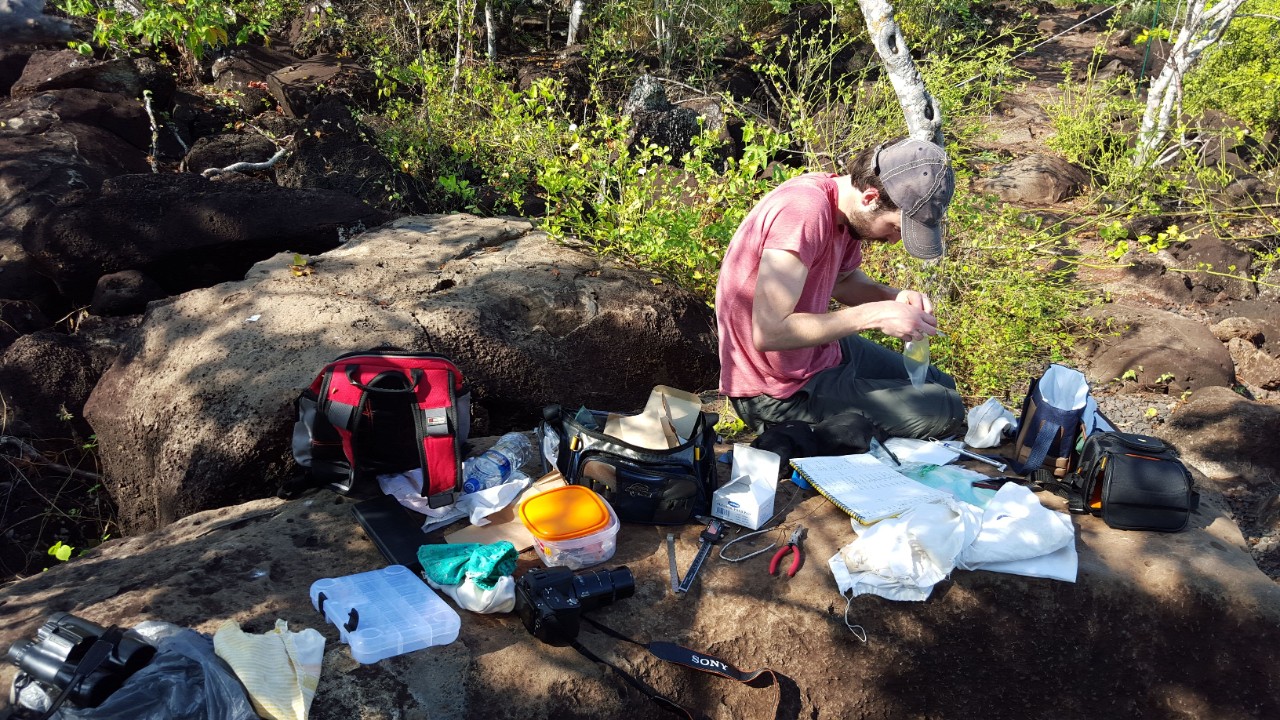
UC doctoral graduate Jack Stenger conducts fieldwork on finches on the Galapagos island of San Cristobal. Photo/Jose Barreiro
The UC study suggests that genetic diversity may not be the best predictor of extinction risk for mobile species like the island-hopping finches. That’s because healthier populations may contribute individuals to declining ones.
Lawson said factors such as historical diversity or the possibility of gene flow between populations should be considered in addition to the snapshot view provided by a genetic analysis for a fuller understanding of a species’ potential for extinction.
“Typically, we would expect populations with high genetic diversity to have a greater potential for long-term survival,” she said. “Meanwhile, the low-diversity populations would be more likely to go extinct because that’s a common pattern as populations decline to few individuals. Surprisingly, we found that most of the extinct populations had higher genetic diversity.”
There is grandeur in this view of life, with its several powers, having been originally breathed into a few forms or into one; and that, whilst this planet has gone cycling on according to the fixed law of gravity, from so simple a beginning endless forms most beautiful and most wonderful have been, and are being, evolved.
Charles Darwin, On the Origin of Species
Extinction is a natural process in the crucible of life, but the impacts of people are increasingly apparent. Conservation biologists are developing new tools to identify species at risk of extinction before it is too late to save them. Scientists in the Galapagos are monitoring the finches to ensure their future survival. But researchers still don’t know what drives some populations to extinction.
Lawson said many factors contribute to local or total extinctions. An island’s size can influence local extinction potential. Small islands offer fewer resources and habitat. Likewise, how generalized or specialized an animal is plays a part as well. Species that rely on very specific habitats or food requirements are more vulnerable to extinction than generalists, for example. And habitat disturbances from human impacts, competitors or invasive species also affect survival.

The feather of a Galapagos finch. Photo/Joseph Fuqua II/UC Creative Services
The study was sponsored in part by the National Science Foundation, Sigma Xi, the American Ornithologists’ Union and UC’s Office of Research.
In a second related UC study, published in the journal Ecography, Lawson, Petren and former UC postdoctoral fellow John Niedzwiecki sought to better quantify movement for the finches within the archipelago to better understand the dynamics of gene flow which so significantly impact extinction potential.
Using mist nets, researchers captured 1,190 birds representing 11 species and 13 of the archipelago’s islands. A tiny blood sample was taken from each bird before their release.
Scientists have several models explaining how animals spread to new islands. Generally, large islands provide immigrants to smaller islands. Likewise, older islands supply immigrants to newer ones over time.
UC researchers looked for a pattern of movement to test these theories in the Galapagos finches. They found that the finches flew against prevailing winds from the smallest outer islands to the biggest central ones, counter to hypotheses. The new arrivals might have been drawn to bigger islands they could see from afar, Lawson said.
“There is a visual cue. Those central islands are so much higher and capture the rain clouds,” she said. “So if you take off, you might see those central islands and say, ‘Land!’”
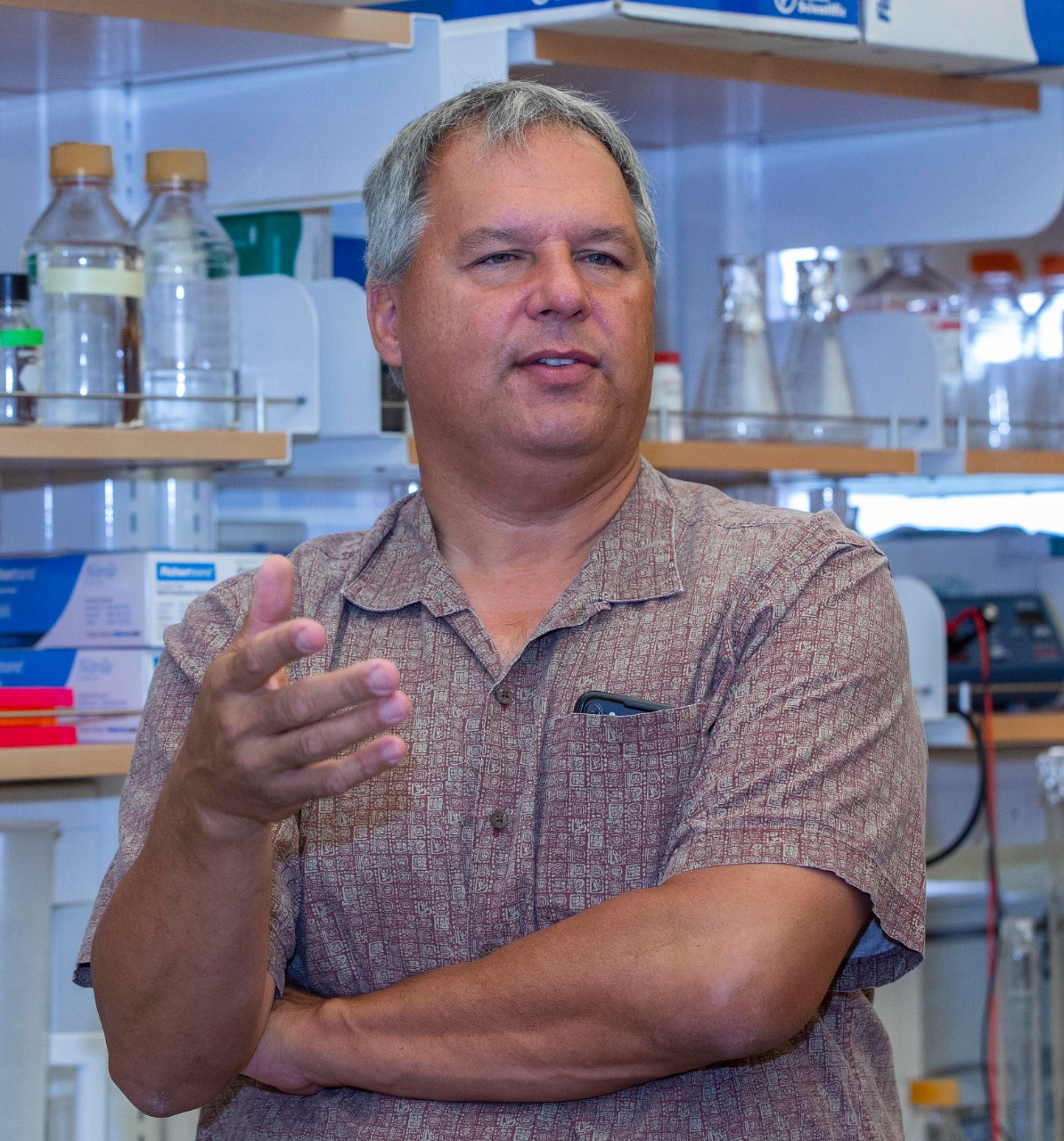
UC biology professor Kenneth Petren has been studying the Galapagos Islands for the past 25 years. Photo/Joseph Fuqua II/UC Creative Services
Galapagos finches are mediocre flyers. They don’t have the physical stamina to leave the archipelago. And what’s worse for birds surrounded by a vast ocean, their feathers are not particularly waterproof.
“If they get hit by a rogue wave, they sink. They’re not well adapted to long-distance flights,” Lawson said.
Conditions on the smallest islands can be especially hostile, with little water and fewer sources of food and cover. In his field notes, Darwin described one such island as “black, dismal heaps of broken lava, forming a shore fit for Pandemonium.” Birds that evolved to cope with these extreme conditions would find comparatively greener pastures on the bigger central islands.
“On the smaller islands, you’d have to be a tough bird to make it. You really need to be tightly adapted to the resources to survive,” Lawson said. “If you’re a soft central archipelago bird and you try to make it on an island like Pinta, you’ll probably die.”
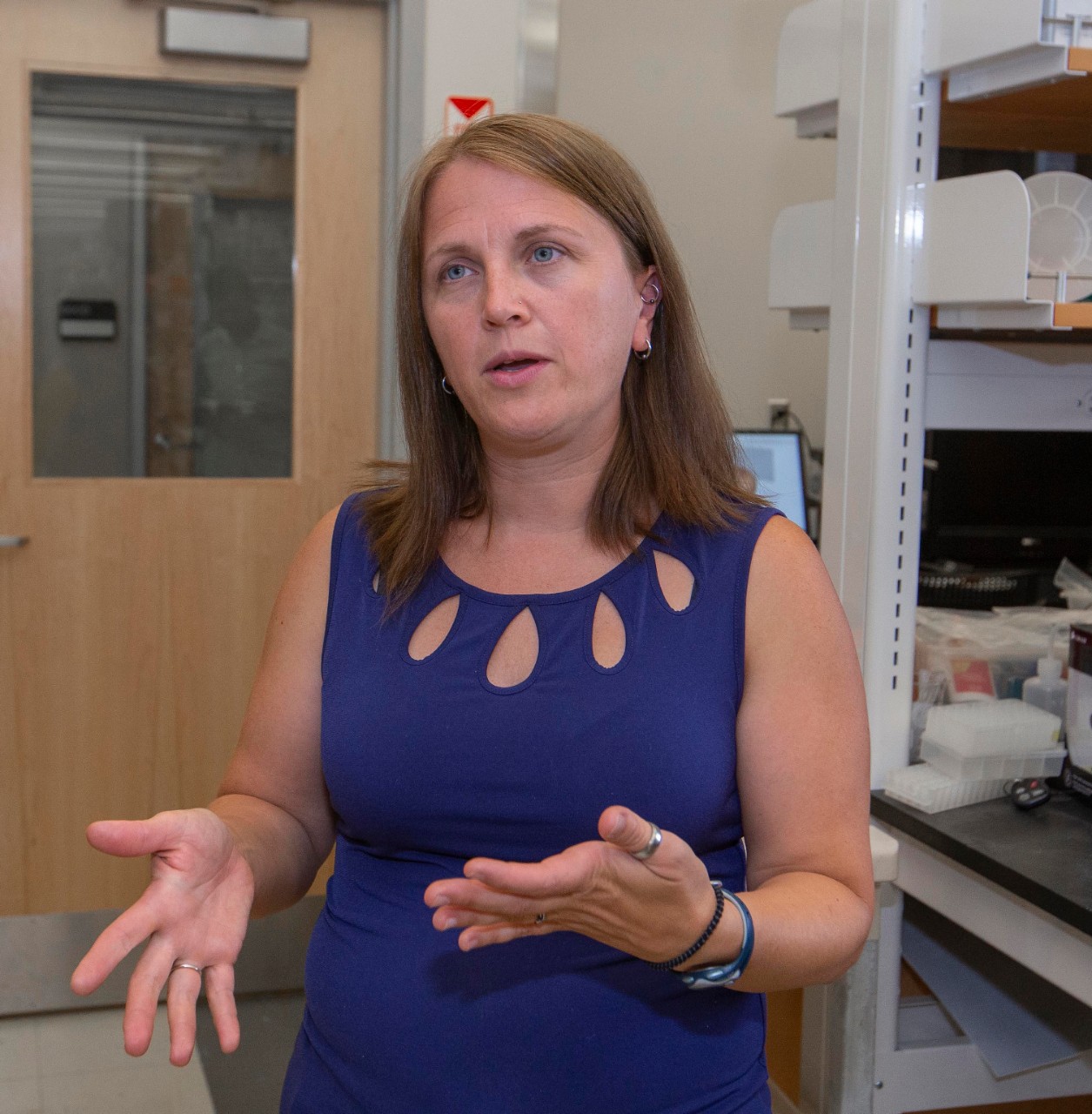
UC biologist Lucinda Lawson said researchers were surprised to discover that populations of Galapagos finches with comparatively lower genetic diversity survived while those with higher genetic diversity went extinct. Photo/Joseph Fuqua II/UC Creative Services
Darwin’s “On the Origin of Species” was groundbreaking in our understanding of evolution through natural selection. “Survival of the fittest” is a household phrase and a shorthand description of any competition.
While scientists today know more about how new species are formed, the principles Darwin developed remain the foundation of evolutionary biology, Petren said.
“Certainly, genetics is new. But the fundamental principles still stand. It’s amazing how much of his work remains fundamentally true today,” Petren said.
While scientists now understand a lot about evolution in the Galapagos Islands, and Darwin’s finches in particular, there is still more to learn, Lawson said.
Petren and Lawson are working with UC graduate student Jose Barreiro, a native of Ecuador, to use advanced analytic tools to capture 3-D shapes of the finches’ beaks to understand the selective pressures on shape that have lead to this rapid radiation of species. This technique allows for a more precise comparison of an animal’s features than previously was possible with callipers and other mechanical means.
Barreiro first visited the Galapagos on a class trip as a child.
“I think the Galapagos occupies a very special place in Ecuadorian identity,” he said.
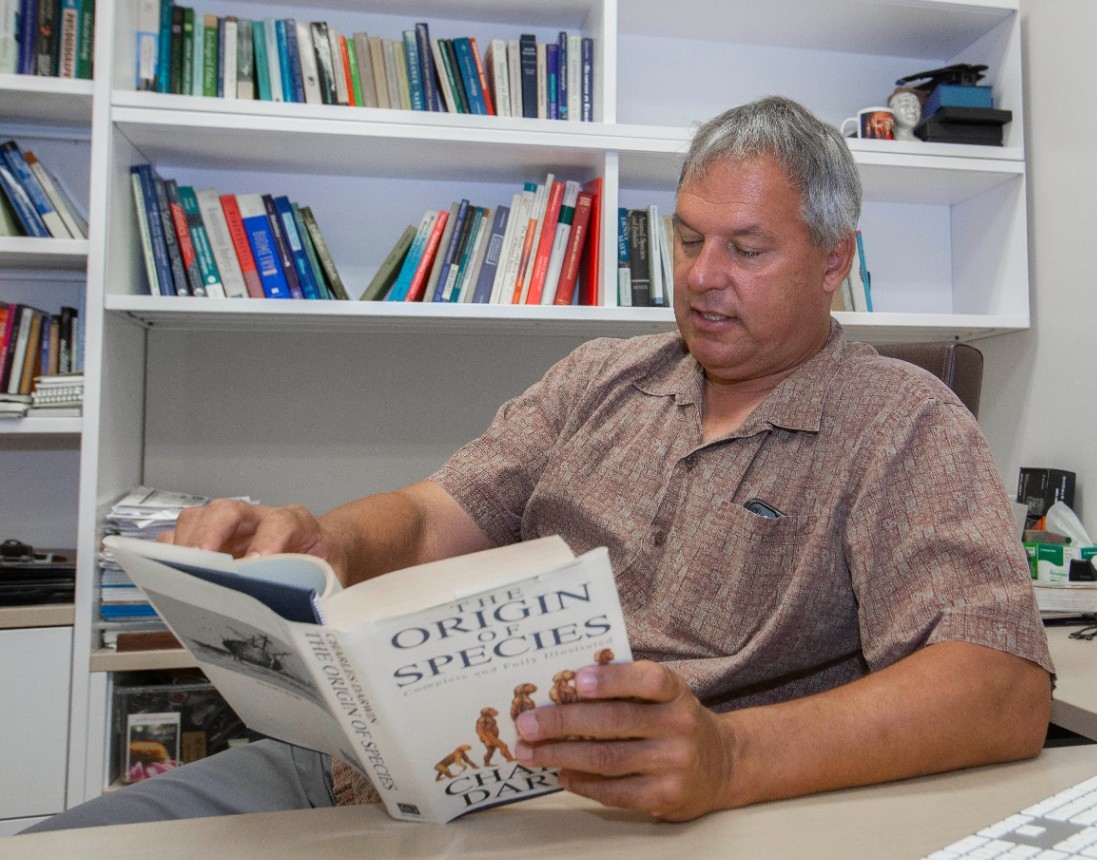
UC biology professor Kenneth Petren reads a passage from Charles Darwin's "On the Origin of Species." He keeps a couple different editions in his office. Photo/Joseph Fuqua II/UC Creative Services
UC’s researchers said the World Heritage Site is special to them as well. Petren led a multidisciplinary Honors class to the Galáapagos to study sustainability on the islands Now Petren and Lawson hope to create a similar experience to examine the islands from scientific, cultural and artistic perspectives.
“What’s cool about the Galapagos is it sparks something in people. Of course, it’s interesting for its geology and biology,” Lawson said.
“But the islands have a lot more to offer than scientific understanding. The Galapagos have their own sounds, their own colors, their own shapes – which could be inspiring for music, art, dance and any creative interpretations of these small desert islands in the middle of the ocean. It would be fantastic to get a diverse group of people to tour and visit the islands and represent UC’s strengths to come up with something collaborative.”
Featured image at top: UC biologists Lucinda Lawson, left, and Kenneth Petren talk about their research in a biology lab with UC graduate student Jose Barreiro. Photo/Joseph Fuqua II/UC Creative Services
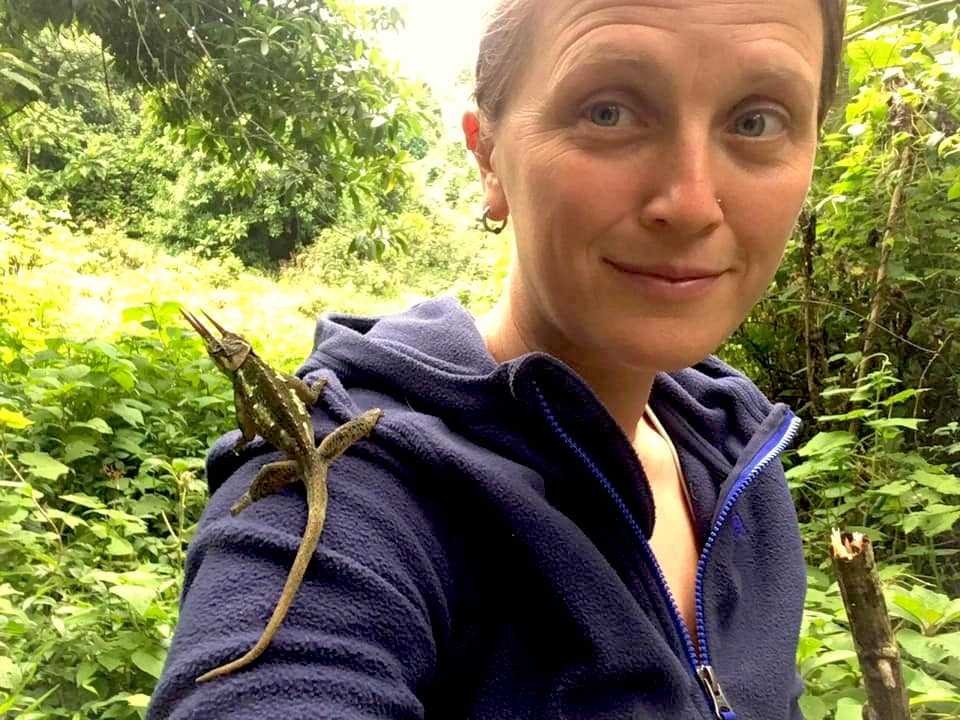
UC assistant professor Lucinda Lawson takes a selfie with a chameleon while conducting research on amphibians in Tanzania. Photo/Lucinda Lawson
Next Lives Here
Discover UC's commitment to Next Lives Here, the strategic direction with designs on leading urban public universities into a new era of innovation and impact.
Become a Bearcat
Do you like the idea of conducting your own biology research? Apply online or get more information about undergraduate enrollment by calling 513-556-1100. Learn more about UC's many undergraduate and graduate programs.
Related Stories
UC celebrates record spring class of 2025
May 2, 2025
UC recognized a record spring class of 2025 at commencement at Fifth Third Arena.
UC students recognized for achievement in real-world learning
May 1, 2025
Three undergraduate University of Cincinnati Arts and Sciences students are honored for outstanding achievement in cooperative education at the close of the 2024-2025 school year.
‘Doing Good Together’ course gains recognition
May 1, 2025
New honors course, titled “Doing Good Together,” teaches students about philanthropy with a class project that distributes real funds to UC-affiliated nonprofits. Course sparked UC’s membership in national consortium, Philanthropy Lab.
